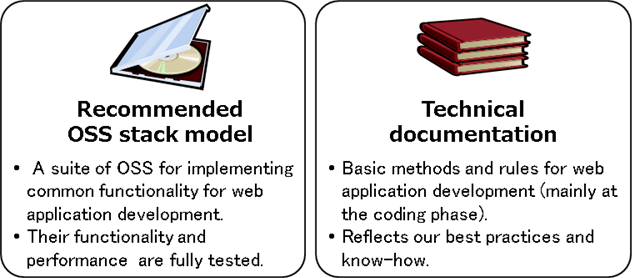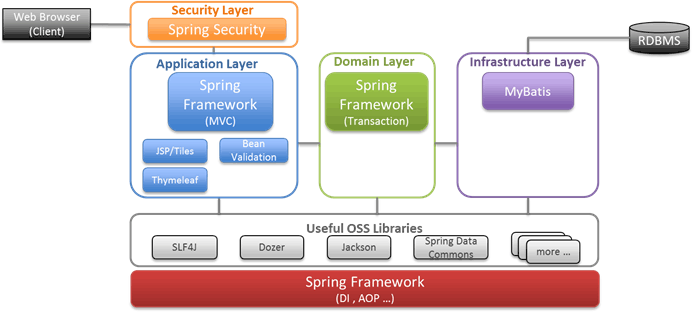Microsoft ends support for Internet Explorer on June 16, 2022.
We recommend using one of the browsers listed below.
- Microsoft Edge(Latest version)
- Mozilla Firefox(Latest version)
- Google Chrome(Latest version)
- Apple Safari(Latest version)
Please contact your browser provider for download and installation instructions.
March 13, 2018
NTT
NTT publishes its Java application framework for efficient software development as open source to contribute to the IT industry
Nippon Telegraph and Telephone Corporation (hereinafter "NTT"; HQ: Chiyoda-ku, Tokyo; President and CEO: Hiroo Unoura) published its application framework*1 "Macchinetta Framework" as open source for developing Java-based web systems using open source software (OSS), continuing its efforts to contribute to the IT industry by supporting the stable and efficient development of high-quality systems.
Macchinetta Framework consists of a recommended OSS stack model, which is a suite of various OSS such as Spring*2 for implementing common functionality, and technical documentation of basic methods and rules for web application development. Many NTT group companies use this framework as their standard, so the technical documentation reflects many of their best practices. By utilizing Macchinetta Framework, developers can achieve uniform quality and high productivity in web system developments.
1.Background
When developing web systems, using OSS is very popular for cost reduction. However, this can cause various problems because OSS are frequently updated to follow new technical trends, and OSS might not guarantee complete functionality in their specifications. In order to avoid these risks when using OSS, those working on software development projects need to research and verify the functionality and performance of various OSS (and their combinations).
In addition, application developers can implement their systems in various methods when using OSS. Therefore, when there is no designated rule for implementation, the methods and quality of implementation vary depending on the developer, making it difficult to promptly analyze reasons for failures and to analyze existing implementations in order to extend them. These circumstances impede the long-term maintenance of applications.
In order to use OSS safely and maintain applications in the long-term, it is very important to research, verify, and designate rules for the reasons discussed above. NTT has continually tackled these problems.
Macchinetta Framework was developed by NTT Software Innovation Center, and about 300 projects have applied this framework since 2014, showing how it has been useful in a practical capacity. Now, NTT publishes Macchinetta Framework so that software developers in the IT industry can use it extensively, thereby eliminating the need for them to research, verify, and designate rules for development using OSS by themselves. In this way, they can achieve uniform quality and high productivity in web system developments.
2.Technical overview
Macchinetta Framework consists of a recommended OSS stack model, which is a suite of OSS for implementing common functionality, and technical documentation on basic methods and rules for web application development (Fig. 1).
It provides a development guideline with a practical implementation method that reflects best practices and know-how obtained from NTT's own application, test programs for checking functionality and performance, a model system for learning the implementation method and considering functionality before development, and more.
 Fig. 1 Overview of Macchinetta Framework
Fig. 1 Overview of Macchinetta Framework
 Fig. 2 Recommended OSS stack model of Macchinetta Framework
Fig. 2 Recommended OSS stack model of Macchinetta Framework
3.Macchinetta Framework website
Macchinetta Framework is available on GitHub at the following URL.
https://macchinetta.github.io/
4.Future work
NTT will continue to improve the functionality and usability of Macchinetta Framework, publish improved versions, and contribute to the advancement of the IT industry.
Glossary
- *1Application framework:
- A collection of software components (including classes and libraries) for implementing the standard structure of an application. It is also referred to simply as a framework. Software developers can efficiently implement basic functionalities of their applications by using reusable standard structures available in the application framework.
- *2Spring:
- An open source application framework for developing mainly enterprise applications using Java.
Inquiries regarding this press release
Nippon Telegraph and Telephone Corporation
Service Innovation Laboratory Group
Public Relations
Email: randd-ml@hco.ntt.co.jp
Information is current as of the date of issue of the individual press release.
Please be advised that information may be outdated after that point.
NTT STORY
WEB media that thinks about the future with NTT











